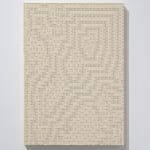Troika
Reality Is Not Always Probable, 2022
6768 ivory dice, 10mm
89 x 63 x 4 cm
35 1/8 x 24 3/4 x 1 5/8 inches
35 1/8 x 24 3/4 x 1 5/8 inches
Copyright The Artist
Photo: Dirk Tacke and Studio Troika
Further images
Reality is Not Always Probable (2022) ist ein Wandobjekt, dessen wellenförmiges Muster sich aus der Anordnung tausender elfenbeinfarbener Würfel ergibt. Ausgehend von Troikas Interesse an den Zusammenhängen zwischen Zufall und...
Reality is Not Always Probable (2022) ist ein Wandobjekt, dessen wellenförmiges Muster sich aus der Anordnung tausender elfenbeinfarbener Würfel ergibt. Ausgehend von Troikas Interesse an den Zusammenhängen zwischen Zufall und Kontrolle stellt die Arbeit die Materialisierung einer computerbasierten Simulation dar. Der Algorithmus, der auf dem Modell des zellulären Automaten beruht, erzeugt spontane Systeme, deren Ausgangspunkt von Troika festgelegt ist. Die Anordnung der Würfel in einer Zeile bestimmt die der nächsten, wodurch komplexe Abfolgen entstehen, die sich nach dem binären Prinzip der Würfelaugenzahl eins oder sechs ergeben. Troikas Würfelarbeiten beziehen sich auf die historische Verwendung von Würfeln als Mittel zur Bestimmung von Schicksal, Zufall und Glück. Der Würfelwurf beruht auf den Wahrscheinlichkeitsgesetzen zu denen der Prozess des Algorithmus konträr verläuft. Er ist autonom und kann unabhängig vom Alltagsleben existieren, während das reale Leben zunehmend durch computerbasierte Systeme beeinflusst wird. Die Arbeit verdeutlicht Troikas Untersuchungen, sichtbar zu machen, wie neue Technologien die physische Realität und deren individuelle Wahrnehmung durchdringen.
Reality is Not Always Probable (2022) is a wall object with a lopsided wave-shaped pattern, a result of thousands of ivory colored dice, upon and beside one another. Based on Troika's interest in the relationship between chance and control, the work represents the materialization of a computer simulation. The algorithm, which is based on the model of the cellular automaton, generates random systems, the starting point of which is determined by Troika. The order of dice in each row determines that of the next, creating complex sequences that are based on the binary principle if the dice show a one or a six. Troika's dice works refer to the historical use of dice as a means of determining fate, chance and luck. The roll of the dice is based in the laws of probability to which the process of the algorithm runs contrary. It is autonomous and can exist independently to everyday life, while reality itself is increasingly influenced by computer-based systems. The work clarifies Troika's investigations into showing how new technologies permeate physical reality and individual perception.
Reality is Not Always Probable (2022) is a wall object with a lopsided wave-shaped pattern, a result of thousands of ivory colored dice, upon and beside one another. Based on Troika's interest in the relationship between chance and control, the work represents the materialization of a computer simulation. The algorithm, which is based on the model of the cellular automaton, generates random systems, the starting point of which is determined by Troika. The order of dice in each row determines that of the next, creating complex sequences that are based on the binary principle if the dice show a one or a six. Troika's dice works refer to the historical use of dice as a means of determining fate, chance and luck. The roll of the dice is based in the laws of probability to which the process of the algorithm runs contrary. It is autonomous and can exist independently to everyday life, while reality itself is increasingly influenced by computer-based systems. The work clarifies Troika's investigations into showing how new technologies permeate physical reality and individual perception.









